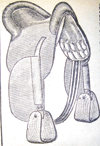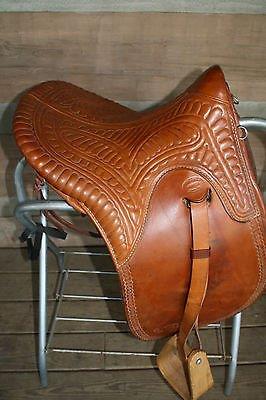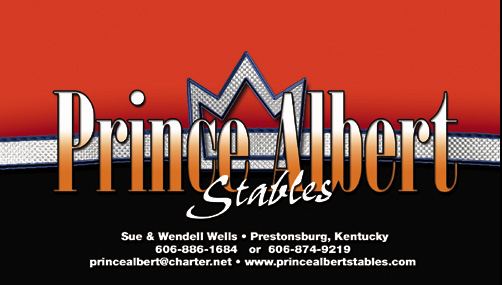The World’s Most Comfortable Saddles
A Stitch in Time
Tim Preston
07/28/2006 – LOUISA It was once widely recognized as the most comfortable saddle in the world.
The Kentucky saddle, sometimes called a Somerset saddle, was the ideal seat for mail carriers, circuit preachers, doctors and others who relied upon horses to get their jobs done. The quilted, padded saddle with wide skirts carried a rider in comfort while helping keep his clothing unsoiled, and the saddle’s design also made movement more natural for his horse.

Despite its reputation, the Kentucky saddle nearly disappeared from existence when movie cowboys popularized the English saddle, according to John Goble of Rockcastle Creek.
“For mail carriers, doctors, circuit preachers or anyone who rode long distances this would have been their saddle of choice. The western saddle is designed purely to work cattle. Today we call them cowboy saddles,” he said.
Goble, a lifelong horse enthusiast and rider, began searching for a Kentucky saddle several years ago when he was having minor back pain.
“Everybody told me I was wasting my time because they were all gone,” Goble said, surrounded by saddles and their skeletons while sitting in the workshop behind his home along Rockcastle Creek near the Lawrence and Martin County border.
A history enthusiast and lifelong horseman, Goble said he was quite happy when a cousin found the “tree” for a Kentucky saddle.
“I ordered some leather and very crudely put one together,” he said, explaining he used the finished saddle for his own riding.
“I found it to be the most comfortable saddle I’ve ever ridden,” he said. The saddle stayed under him until, “To my surprise somebody bought it.”
He then managed to make another, and then another.
“It started out slowly, just by word of mouth. Then it just got out of hand,” Goble said with a smile. “I told my wife I had to either quit or get a sewing machine.”
Rather than quit crafting the historic style saddles, Goble got an old Singer brand “shoe patcher,” made for leather work. As word of his work spread, people began bringing him the remains of saddles left behind by past generations.
“Most of them still rode. A lot of them were people who are now middle aged people who remember them or rode them when they were young. There wasn’t anybody in this area building them anymore,” he said.
Many of the saddles he rebuilt were originally constructed by James Monroe Sloan, whose saddle shop was in Paintsville until the mid 1950’s. Others were made by John B. Sanford of Cattletsburg, Perry Foster or Robert Hutchinson, both of whom built their saddles in Elliott County, or Herb Hutchinson of Morehead. Goble tends to be able to identify a saddle by its maker as soon as he sees it, noting this state once boasted an abundance of “excellent saddlers.”
The Kentucky saddle, sometimes called a Kentucky Stretch Down saddle because the seat is stitched down onto the skirts, begins with a hinged wooden frame, the “tree,” which gave the seat its spring.
The tree is padded with animal hair, typically from goats, before the saddler adds wide leather skirts to fit between the horse and the rider’s legs, Goble explained. A pad of hair supports the weight of the rider’s legs and helps evenly distribute the overall weight of the rider across a wide area of the horse. The top leather seat is then stitched to cloth with the saddler’s signature pattern and then hand stuffed with cotton.
“I always try to copy the pattern used by the original saddler,” Goble said. The intricate stitch pattern is sewn using a heavy duty machine powered by a foot treadle, allowing Goble to maintain accuracy and control his stitching speed.
“You have to be slow with these things. If you are stitching leather and make a mistake you have to throw that seat away,” he said, explaining a missed stitch will cause the saddle to split.
Working at top speed, Goble estimates he can build a saddle (using an existing saddle tree) in about eight hours, but cautions, “you can’t do that all at once.”
Goble predicts the Kentucky saddle will never again be built on a commercial scale.
“They are so labor intensive. Nobody is going to build them unless they love ’em,” he said, adding. “Before I stopped I could build one in a week.”
Due to personal reasons, Goble’s saddle shop is now silent, although he does someday intend to build again. He also hopes to pass the things he has learned onto the next generation of saddlers when he gets back into business.
He continues to work as a social studies teacher at Inez Middle School, and tend to his duties as pastor of New Friendship United Baptist Church.
“Right now, I’m not operating a shop. My hope is, if I get to retire, to go back to building. Two or three guys have shown an interest in learning how to do it. I would like to see somebody pick it up. This was once a thriving business in every community,” he said.

Social studies teacher and horseman John Goble (above) places one of his own hand crafted Kentucky saddles on his favorite ride ‘Blueboy’ outside his home along Rockcastle Creek near the Lawrence/Martin County border. The Kentucky Saddle, also known as a “Somerset Saddle” was offered in the 1908 Sears & Roebuck catalog for $8.99. The saddle was once widely recognized as the seat of choice for doctors, mail carriers, circuit preachers and others who traveled long distances on horseback. BSN photo/Tim Preston

